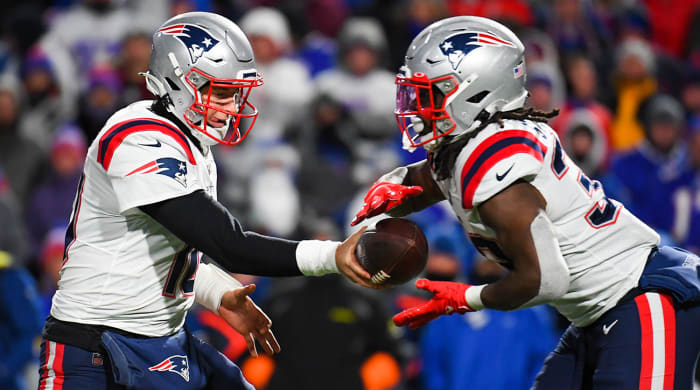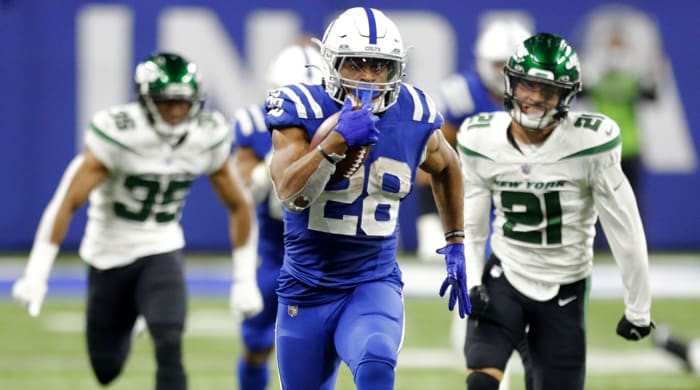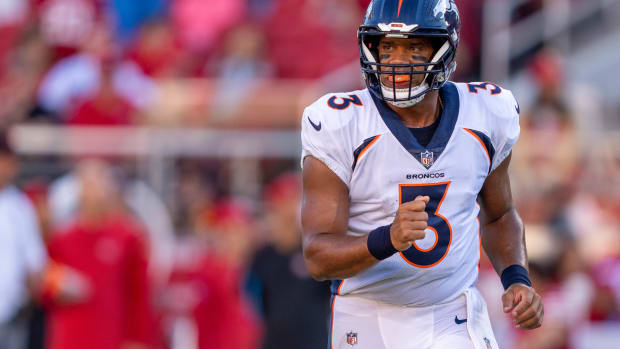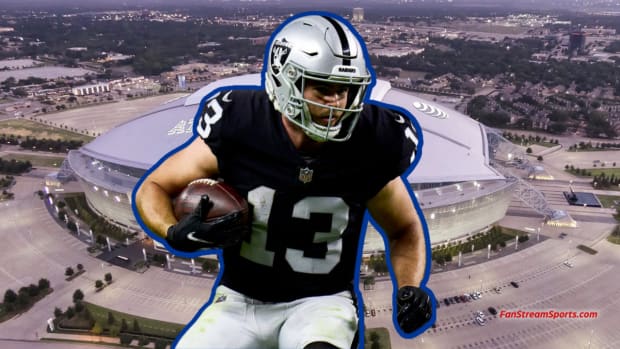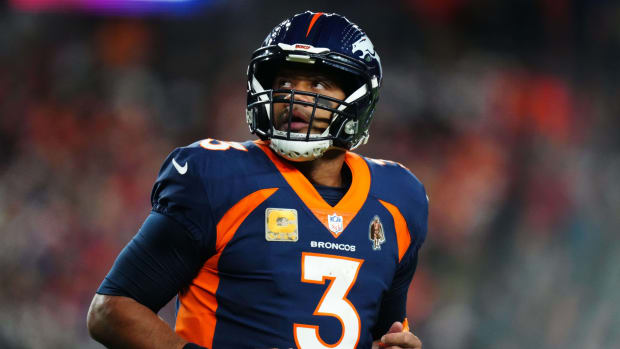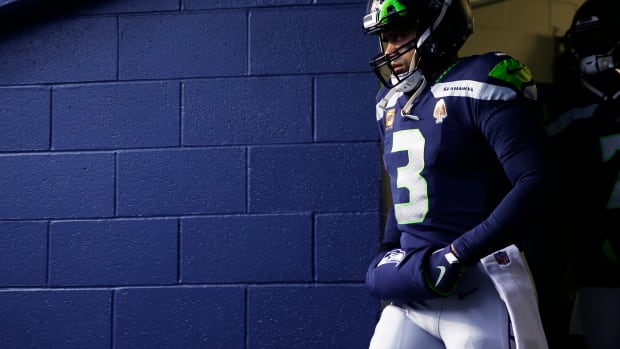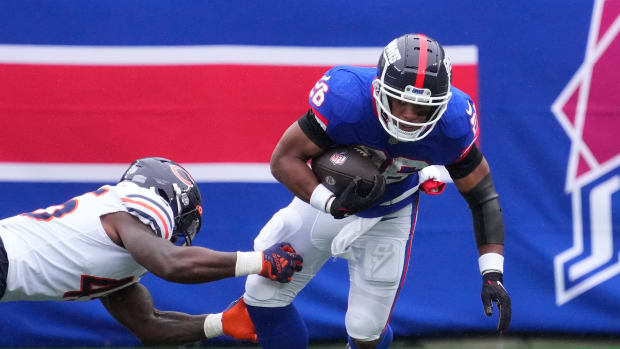GamePlan: How and Why the Run Game Is Making a Comeback in the NFL
There are two statistics from Monday night’s Patriots-Bills game that you probably haven’t seen yet, that will tell you as much about how New England did what it did—turning a showdown into tractor pull, and subsequently grinding out a battle of wills—as anything.
• Bills linebacker Tyrel Dodson played 27 snaps on defense.
• Bills cornerback Taron Johnson played 22 snaps on defense.
Johnson, the Bills’ nickelback, signed a three-year, $24 million extension at the beginning of the season, recognition from the Buffalo brass that the former fourth-round pick had emerged as one of football’s premier slot corners. Dodson, conversely, was an undrafted free agent in ’20 and plied his trade the last two years primarily as a special-teamer, having taken just 51 defensive snaps in 11 games this year before Monday.
The Bills didn’t play Dodson more than Johnson by choice. The Patriots essentially forced them to do it by implementing the plan they did.
It’s just one example of why, as the ’21 season has worn on, the NFL has seen run games surge on a stage set for outsized passing numbers. And New England is just one in a slew of teams pulling it off. We’ve seen it from the Eagles, Colts, Ravens, 49ers and Titans, too—and it’s not just those teams leaning on the run game. It’s those outfits winning on the ground, and for an easy-to-understand reason.
Most teams, in 2021, are built to throw the ball and stop other teams from throwing it.
The aforementioned half-dozen have essentially combatted that by throwing hands, taking the bet that big people can still beat up little people.
The interesting part is the guys leading teams the way Bill Belichick led his on Monday didn’t just decide to do it this way on a whim. They’ve built themselves into it—with the kinds of the rosters that can, in an era where conventional wisdom is leading others not to. So, sure, seeing either a nickel defense or a linebacker who barely plays out there was an invitation for the Patriots to run it 46 times on the Bills. But it wouldn’t be for everyone.
“If you're built to win that way, then it is a huge invitation [to run],” said one NFC head coach on Thursday. “But not everybody's built that way, right? A lot of teams are built skill- first. And so it is an invitation, but if you go out there and you're not built for it, and you go two-yard run, two-yard run, two-yard run, a lot of coaches get impatient with that.”
Belichick didn’t. The rewards were obvious. Look closely enough, and the trend here is, too.
We’re into the final quarter of the season, and we’ve got plenty for you to prepare for Week 14 in this week’s GamePlan. Inside the column, you’ll find …
• A preview of the week’s biggest games, starting a huge interconference tilt.
• Story lines to follow, with some insight into the Chiefs’ blueprint teams have drawn.
• Some (improving!) gambling advice.
• Why we might see a few more in-season coach firings than you might expect.
But we’re starting with the rebirth of smashmouth football in the NFL, and how we got to the point where the smart play is turn back the clock.
In working through reporting this story, I got a lot of analogies. Two stuck out. One involved football, just at a different level.
“It’s Alabama football, right?” said one NFC exec. “You look at what the University of Alabama has done under Nick Saban, the rest of college football isn’t fit to deal with what Alabama does offensively or defensively. Everyone is built to play spread-out football, let’s get in 11 personnel, let’s play nickel. Alabama repeatedly just does what they do. We’re gonna be bigger than you. We’re gonna be stronger than you. We’re gonna beat you up.
“They make tweaks and changes to evolve, but their core principles are the same. Say there are 120-some-odd Division I schools. They’re all fit to defend each other because there’s more teams running the spread. Nobody’s fit to defend Alabama, except maybe Georgia, and you look at Georgia, all Kirby [Smart] did, he just took Saban’s s---. Now, they’re getting their talent level up to the line of Alabama, and they’re just trying to f------ run through people.”
The second, with this particular exec, was a basketball analogy.
“So many teams want to play Golden State Warriors football. They want to sprint up the field, take shots—hit the three, if you will,” he continued. “Not many teams in the league can afford to get in those types of shootouts against a Kansas City. We have to break it down, we have to play half-court basketball. We have to play possessions and keep the ball out of your hands. The best way to do that, obviously, is to run the ball and control the clock.”
Both comparisons make this sound easy to pull off. But it’s really not.
It takes time, effort and intention. It takes resisting the urge to mimic teams like Kansas City, in order to build a roster to counteract what they and so many others are doing. And there are a number of steps to take that wind up adding up.
It starts with how a team is built. And while stats that running backs like Derrick Henry and Jonathan Taylor pile up that illustrate the point here, it’s who they’re running behind that really matters most.
“If you wanna be tough, and work at establishing the run, you have to have the personnel to fit that,” said one AFC GM. “That starts with the line—in team construction, the line of scrimmage is the foundation of the house. If you have a sh---y foundation, then the first storm is gonna blow the house over. It doesn’t matter how nice you made the house. If the line can’t open a hole for a running back, you can’t make a yard.”
“I think it’s a response to the coverage systems and the personnel groupings that are being played,” an AFC head coach added. “I think so much of the engineering of defenses is for the passing game, so some of these run performances are more reflective of that. But you still have to have the personnel offensively to be able to play like that. The Patriots and Indianapolis, they’re built structurally to run the football, in terms of the lines they have.”
So that’s the obvious part. The other piece is less obvious. It’s carrying blocking tight ends or fullbacks as part of your investment into your skill position. And there’s reason for that too—one brought to life in the Dodson/Johnson equation the other night.
49ers coach Kyle Shanahan, a couple of summers ago, explained it to me clearly, in trying to boil down why fullback Kyle Juszczyk was so valuable to him, and why playing 21 personnel (two backs and a tight end) is almost like a cheat code in today’s NFL. Like we saw from the Patriots, it’s about forcing the other team to put players on the field they don’t want to play, while knowing you’ve reduced the volume of scheme you’ll see exponentially.
“There are always cycles,” Shanahan said. “That’s why to me, there’s no absolutes. That’s why I use 21 probably more than anyone in the NFL; we have a fullback in there, not just because that’s our offense, it’s because I believe that’s an advantage. People don’t play base defense very much because the majority of the league doesn’t have a fullback. And so you get people on the field they’re not as used to practicing with. You know their menu’s smaller.
“And it’s, Alright, I know I’m attacking these five things instead of these 25 things. And you can see it better as a play-caller, as a quarterback. But also, it can be an advantage for the defense. If there’s only two receivers out, that’s a lot easier to defend than having to deal with a slot receiver. That’s why it’s important to me to have a fullback like Juice where you can do two-back, but you also can be in one-back and do one-back type stuff.”
The second piece is how a team practices in the summer. There’s a reason why teams that aren’t physical on offense wind up being less-than-sturdy on defense—during spring work and into training camp, the offense is whom the defense is getting its reps against. So if the offense is trying to become the June Jones Falcons, chances are the defense isn’t getting a ton of work analogous to what they’ll readying for when it’s Baltimore Week.
“If you’re playing fullbacks, playing 21, teams won’t have practiced against it, and teams really don’t see it much,” said an AFC exec. “And once you get into the season, it’s hard to practice those things full speed—you won’t have guys coming downhill the same way. … And if you’re playing gap scheme [rather than zone], teams just don’t see a lot of that either, and it forces you to control gaps and defeat blocks.
“It forces you to play big-man football.”
And for a lot of teams in ’21, playing true big-man football is a nonstarter.
“They’re smaller to begin with, because everyone’s playing the pass,” said an AFC offensive coordinator. “Most draft picks in the first round are connected to the pass game, as they should be, because if you can’t throw it, stop the pass, rush, cover and make explosive plays, you can’t win anyway. But if you look at all these fronts, they may have a guy or two that’s really a run player. Mostly, they’re not.
“So you get guys who can run sideline to sideline, they can cover, they’re good tacklers, but they’re not playing blocks right, they don’t take on guards and nobody’s used to playing the fullback. Most of these defenses, all they play is nickel. So what do they do if we’re in 21? You can maybe find 12, 14 snaps in base all year. They have no experience with it. And when you don’t practice against something all year, not gonna get good at it.”
The catch here? You have to be able to play good defense, too. The reason? Sometimes playing offense that way takes patience—with the effect of a powerful run game being cumulative, and playing from a deficit being more difficult if that’s your style.
“Part of it is there are not enough offensive coordinators that are patient enough to stick with it,” said the AFC exec. “Those teams you mentioned, they have to play complementary football. None of those teams have a sh---y defense. It’s harder to play from behind, you can’t really subscribe to that theory if you’re always doing that. So you have to have a defense that can stop you, so you can stay in range while you’re playing that game.”
That’s where, eventually, teams like these are able to flip the frustration on their foes.
“The mix of stretch with the power scheme, gap scheme stuff, you get that thing rolling, and that’s a long day’s work for the defense,” said an AFC defensive coordinator. “Then, those other teams will try to blitz the run, and that’s when they get creased.”
“It’s a mindset,” said the AFC GM. “If you can’t stop the run, it’s hard. Everyone’s searching for answers, and they just keep running, running, running, and you can’t get the ball back, the other team’s keeping it the whole time—it’s demoralizing.”
So how is it manifesting as the season’s worn on?
The Eagles have rushed for 200 yards as a team four times, and all four have come since Halloween. The Patriots have gone for more than 150 yards three times, and all three were after Nov. 1. Likewise, the 49ers’ top three rushing outputs of the year, all besting 155 yards, have come since Nov. 1; as have the Colts’, with each of those efforts landing north of 230 yards. The Titans’ top rushing number for the year, 270 yards (without Derrick Henry!), was during Thanksgiving week. And the Ravens had a 247-yard day on Nov. 7.
Now, to be sure, this doesn’t mean the NFL as a whole is going back to ’60s. But it does show, once again, how cyclical the sport itself is, and how it’s set up for these sorts of cat and mouse games to play out.
Basically, in the NFL, if you have a weakness, smart teams are going to find it, rip that scab open and try to bleed you dry. And it just so happens that a lot of teams have the same weakness right now.
“Everything’s cyclical,” said the AFC head coach. “I would say the running game, just in general, it forces your operation, both ways, to be good at the essence of the game, which is blocking and tackling.”
On Monday night, it turned out that the Patriots were pretty good at those things.
And truth be told, given the conditions, they really didn’t need much else.
FIVE STAR MATCHUP
1) Bills at Buccaneers (Sunday, 4:25 p.m. ET): Tampa Bay has responded emphatically to a 29-day stretch without a win, with three straight victories, two of which came on the road. So it’s not hard to see how they Bucs would be rounding into shape like they did around this time last year. And coming into town is a Bills team that badly needs a slump-buster, and will be facing a boogeyman for a second straight week—Tom Brady is 32–3 in his career against Buffalo. Win the game, and Buffalo can look at the rest of its schedule (vs. Panthers, at Patriots, vs. Falcons, vs. Jets), feel good that it can climb back to 11 or 12 wins. Lose, and the Bills are 7–6, and fighting to even get into the playoffs. Big stakes here, and a good chance to get a read on both teams.
2) Rams at Cardinals (Monday, 8:15 p.m. ET): Arizona can clinch a playoff spot on Monday night. And while the Cards can’t quite mathematically put the division away, a win over L.A. would realistically end the race for the NFC West crown. And for the Rams, beyond just having a chance to win the division, this should be a good test of where they are physically after getting beaten badly at the line of scrimmage by the Titans and Niners over the last month. In beating the Rams on Oct. 3, Arizona used a similar formula—piling up 216 rushing yards on 40 attempts (and really, it was 218 yards on 38 attempts, if you eliminate a couple of kneel downs).
3) Cowboys at Washington (Sunday, 1 p.m. ET): Dallas’s margin for error in an NFC East race that was declared over a month ago has continued to shrink—and Washington is looking at very real opportunity here. The Football Team is just two games back of the Cowboys, with two games against Dallas in its next three (the rematch is Dec. 26 in Arlington). And Ron Rivera’s crew has won three straight, and is the defending division champ, so the Cowboys are going to have to bring it for this one. The win in New Orleans was a good step forward. We’ll see if they can build on it.
4) Ravens at Browns (Sunday 1 p.m. ET): The Ravens’ coaching staff has done a mostly masterful job in 2021—navigating an ever-growing list of guys on injured reserve and continually reshaping the team to the players on hand. But it won’t be easy from here. Baltimore has the Packers, Bengals, Rams and Steelers after this one, and last week brought more bad injury luck, with No. 1 corner Marlon Humphrey lost for the year. On the flip side, Cleveland’s 6–6 and teetering on the fringe of the AFC playoff race as it comes off its bye, with Baker Mayfield, presumably, in a healthier spot to pilot the offense down the stretch.
5) 49ers at Bengals (Sunday, 4:25 p.m. ET): Both teams stubbed their toes last week. Both teams are right at the playoff line in their respective conferences. So this is a very big game for both, and a fun matchup for the rest of us featuring two of the more intriguing offensive groups in the league (and Joe Burrow’s pinky finger adds a layer of drama to the game, too).
Watch NFL games online all season long with fuboTV: Start with a 7-day free trial!
FOUR THINGS TO FOLLOW
Will the Raiders adjust? A book’s been written this year on the Chiefs’ offense—play two safeties high and take your chances with everything else. It’s forced Kansas City to play a more patient, conservative game and, without question, has taken Patrick Mahomes, Travis Kelce and Tyreek Hill out of their element a little. I think they’ll eventually figure it out. But this week presents an interesting question. Will the Raiders challenge the Chiefs the way others have? Kansas City’s won five straight despite playing at a relatively ordinary level offensively through that that stretch, with a 41-point, 516-yard effort in Vegas on Nov. 14 being the exception. And why was it the exception? The Raiders didn’t follow the blueprint, sticking to their standard Cover 3 looks, and Mahomes & Co. ate them up as a result. We’ll see if Gus Bradley, tried and true to the Pete Carroll system, tweaks things to reflect what’s giving Kansas City trouble this week.
The Panthers’ coordinator change. It flew a little under the radar, because it was announced as last Sunday’s games kicked off, but second-year Carolina coach Matt Rhule fired offensive coordinator Joe Brady—one of the hottest coaching names in the sport seemingly five minutes ago—and the team will move forward with senior offensive assistant Jeff Nixon, Rhule’s OC at Baylor, at the trigger. They have the Falcons this week. But more than just what’s right in front of Carolina, where the Panthers go with that position into next year will be vital to where Rhule’s program winds up going. A lot of things have been accomplished the last two years in Carolina. The defense is young, and looks like it’s got a great future. There are foundational pieces on offense, if some holes. But there’s still not a franchise quarterback, and now we don’t know who’ll be running the offense if the Panthers land one in 2022. So is Nixon the answer? He has five games to convince Rhule that he is, and not to go outside the building to find one.
Will Justin Fields show progress? The rookie’s injury has given him a couple of weeks to reset, and he’ll return to play on a big national stage coming out of that. And we know that wherever the Bears go from here, both through the rest of this season and after it, they’ll be going there with Fields’s development front of mind. That means if Matt Nagy and his staff have any shot at surviving, they have to show they can get the most out of Fields now. Or else the Bears will start looking at names you’ve heard, like Sean Payton, Josh McDaniels and Ryan Day. The good news is that, before struggling against the Ravens, Fields’s play had started to pick up in competitive losses to the Niners and Steelers.
Watch NFL games online all season long with fuboTV: Start with a 7-day free trial!
How do the Jaguars look? Between Urban Meyer’s benching of James Robinson, the explanation, and then quarterback Trevor Lawrence’s response (“He’s got to be in the game”), there will a lot of eyes on how engaged Jacksonville’s players are this week in Nashville. Here, for clarity’s sake, is Meyer on the situation: “You bench yourself. If you lay the ball on the ground, you come out for a few plays, and then it’s up to the position coach and whatever to put you back in whenever that’s time. And that’s not [just] James. That’s whomever. When the ball goes on the ground, you come [out].” Meyer’s not the first coach to send this sort of message to players on turning the ball over, and usually those messages are sent in emphatically when a coach is new. So this isn’t the wildest thing ever. That said, having the quarterback take up for Robinson is notable, as is Meyer’s plan to be involved in when a player in such a spot goes back in. We’ll see if the Jags rally out of a weird situation.
TWO BEST BETS
Season record: 11–15 (My first 2–0 week was followed by my second 2–0 week, and now we are ROLLING).
Titans (-8.5) vs. Jaguars: Tennessee’s coming off its bye, still smarting from a decisive loss to the Patriots (not to mention a bad loss to the Texans before that) and getting healthier. They haven’t won a game in a month. I’d be surprised if they don’t look really sharp on Sunday.
Ravens (+3) at Browns: This feels like a three-point game either way. My expectation is that Baltimore, injuries and all, will be able to play the game on its terms, and get the game into the fourth quarter at the very least.
THE BIG QUESTION
When will we start hearing coaching carousel news?
It could happen soon.
A new rule implemented earlier in the season allows for teams to start interviewing candidates during the last two weeks of the regular season—which means those playing out the string with a lame-duck coach will now have a very real motivator to pull the plug early. And if some team goes through with such a move on Christmas weekend, it’s not far-fetched to think there could be a domino effect.
It won’t make for the best football the last two weeks of the season, but it’d likely be the product of what’s always a competitive job market.
Why? Well, let’s say Team X fires its coach and Team Y doesn’t. That allows Team X to start talking to candidates freely. From there, Team X talks to Candidates A, B and C. And, for the sake of playing this out, let’s say Candidate B knocks it out of the park. The two-week window, regardless of what the rules say, would effectively allow Team X to start putting its ducks in a row for Candidate B.
And if Candidate B takes the job the day after the season ends, when Team Y is just firing its incumbent coach? Well, then Candidate B is going to be able to assemble a staff without as much competition. At that point, Team Y will have lost the opportunity to see if Candidate B is right for it and be looking for a coach with some of the assistant coaches that coach might bring with him already off the market.
Bottom line, Team Y would find itself in a less advantageous situation—and be in it … why? To maintain stability for the last two weeks of a lost season?
Personally, I think this could be a serious consequence of the new rules.
So buckle up. We’re two weeks away.
More NFL Coverage:
- Tom Brady Wins 2021 SI Sportsperson of the Year
- Mailbag: What Do NFL Evaluators Think of Bryce Young?
- Goff Deserves to Feel Good After First Win With Lions
- 2022 NFL Head Coach Carousel Primer
Sports Illustrated may receive compensation for some links to products and services on this website.
































